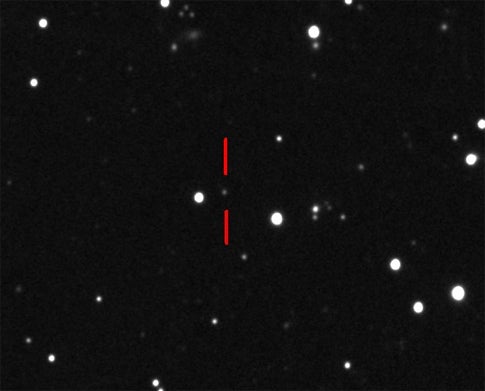The American Association of Variable Star Observers (AAVSO) is pleased to announce the discovery of a gamma-ray burst optical afterglow by Finnish amateur astronomer Arto Oksanen on October 10, 2007. Oksanen, a long-time AAVSO variable star observer and member of the AAVSO Council from Muurame, Finland, was the first to find the optical counterpart of GRB 071010B, a gamma-ray burst detected by NASA’s Swift satellite. Oksanen made his discovery from the Hankasalmi Observatory, a 40-centimeter telescope run by a group of amateur astronomers in Finland. He used the approximate location of the burst determined by Swift, and began imaging the sky within just a few minutes of detection by the satellite. His early images of the sky showed a new object at the position of the gamma-ray burst, and subsequent images showed the object becoming dimmer with time — a possible signature of a gamma-ray burst afterglow.
Gamma-ray bursts are believed to herald the deaths of distant stars, millions or billions of light years from Earth. GRB 071010B had some of the hallmarks of a particular kind of supernova — the collapse of a supermassive star and the formation of a black hole from the remains. When massive stars reach the ends of their lives, they can collapse into neutron stars or black holes. Gamma-ray bursts are believed to occur when the formation of a black hole deep inside the star causes the emission of jets of high-energy particles moving at nearly the speed of light. The interaction of these jets with the outer layers of the collapsing star produces light at all wavelengths from gamma rays to radio waves. When the light from a gamma-ray burst is also detected at wavelengths visible to the human eye, it is known as an optical afterglow. The detection of such afterglows enables scientists to study the explosion that generates the gamma-ray burst and also to measure the distance at which the burst occurred.
Large telescopes around the world, including the Gemini and Keck telescopes in Hawaii, used Oksanen’s observations to measure the properties of GRB 071010B in detail. Both the Gemini and Keck Observatories measured the redshift of the afterglow, and found that it is at least 7 billion light years distant from us — the explosion we observe now occurred in a distant galaxy before the Earth had even formed. Oksanen’s quick action enabled the wider astronomical community to follow up this gamma-ray burst and learn more about this fascinating phenomenon.
The discovery of gamma-ray bursts requires quick action because they fade to invisibility within minutes or hours. Currently there are several robotic telescopes located around the world that automatically search for gamma-ray bursts within seconds of detection. But sometimes a human observer can make these discoveries, particularly when other professional observatories or robotic telescopes are in daylight, experience poor weather or are not in action. As Arto noted in a message to the AAVSO email discussion group, “… you have to be very lucky (and others have to be unlucky) to discover a GRB afterglow nowadays. The sky location of this GRB was a big advantage for me as I was able to observe this one right from the alert being able to ‘look over the North pole’. And this was a bright afterglow and also the weather was good (just after two weeks of cloudy nights). Hard work pays off, I have been hoping and trying to do this since 1997 when I got interested about GRBs. Indeed at last!”
Dr. Arne Henden, Director of the AAVSO, states, “This discovery of a gamma-ray burst afterglow by an amateur astronomer demonstrates how valuable amateurs have become to the professional astronomical community, providing high quality observations and real-time data essential to pointing major telescopes like Keck and Gemini towards these fascinating objects.
Oksanen is the first amateur astronomer to discover the afterglow of a gamma-ray burst since L.A.G. “Berto” Monard of Pretoria, South Africa detected the afterglow of GRB 030725 in July of 2003. The AAVSO community extends its most sincere congratulations to Arto Oksanen on this very exciting discovery!










